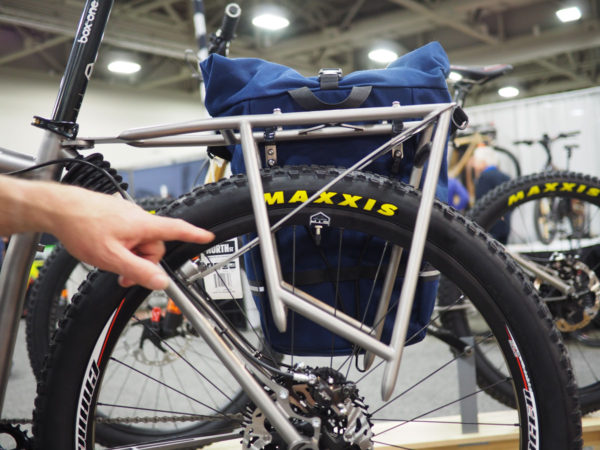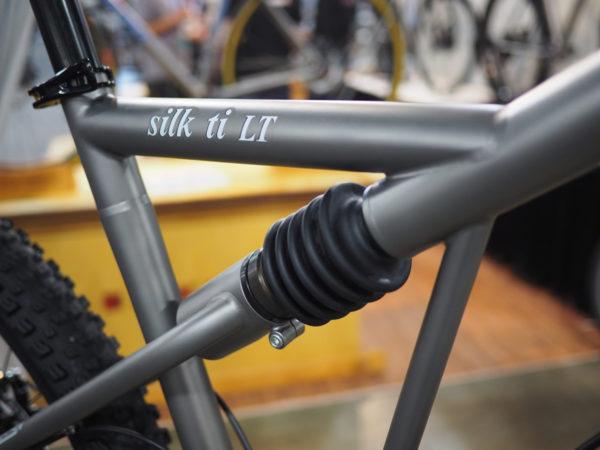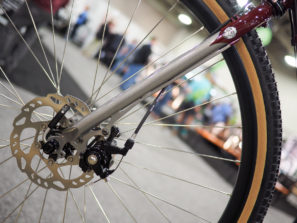When you understand the thought, understanding, and development that goes into something like the Type II fork, you can see how subversive he is as a bike building and design talent. Rather than aggressively adopting and reinterpreting the components available with flashy paint jobs and kits as many other builders at NAHBS do, Steve bucks big industry through developing and fine tuning the “rigid” frame and fork and their relationship to the individual customer in a way that cannot be replicated in production. See, Steve’s not as susceptible to new technology as other builders. He knows he doesn’t have to play by big industry trends… and he never has, as one of the extremely rare bicycle builders or designers in the world who have designed bikes holistically- frames, forks, components, and all.
That said, I was ecstatic to see what was coming across the social media on the Steve Potts channel prior to NAHBS. Out of all of the previews I’d seen for framebuilders coming to the show, his booth became my main draw. Out of three pivotless suspension frames he has developed with John Castellano, two would be making their way to NAHBS. “There are no parts to wear out, they are incredibly strong, and they are super comfortable to ride.”
First up is the Silk Ti XC bike with 1.75in rear travel. Steve has been building Castellano suspension bikes for fifteen years at a rate of about ten to twenty bikes a year. Without a pivot, the suspension is inactive when you’re out of the saddle so it climbs like crazy. “With the unified travel rear triangle, you don’t activate the suspension unless you’re on the saddle… so this is a super duper suspension bike. Basically, it kicks butt.”

The chainstays of each of the pivotless frames were optimized using finite element analysis for their unique purpose- flexing of course. So the 1.75in travel bike has these chainstays, designed to handle a smaller displacement.
Steve demonstrates the deflection shape of the chainstay in compression.
As impressive as the frame is this suspension rack design. “I made this rack two nights ago; it was an all-nighter.” As the multi-phase elastomer shock compresses, the rack structure is also allowed to compress.
Steve found himself having to move the shock inside of the front triangle due to space contraints between the seat cluster and the tire to accommodate 3.3in of travel for the Silk Ti LT.
The resulting frame configuration is boss.
Again, Steve points out the areas where the stays are designed to flex to accommodate the extra travel. “This chainstay development is 15, 20 years old… we’ve had a lot of these out and we’ve never had one break. They are incredibly strong.”
Beyond titanium, the booth also featured several more affordable steel bike options. Why build these affordable, steel versions? “I love building bikes and I want to get more people on [them].”
This white steel trail bike was designed around 27.5+ tires (specifically 3in tires on a 45mm rim), a Boost drivetrain, and Pass and Stow Racks. It’s also paired up with a new Type II plus fork, designed with straight 1-1/8in and tapered 1-1/8 to 1-1/2in steerers.
There was also this gravel adventure bike, also available. With clearance for up to 50mm tires, your options for surfaces are wide open with this ride.
To accomplish this build, Steve made a Mini Type II fork around it. Many builders or manufacturers just use really stiff and heavy steel blades to strengthen them for disc brakes. That’s not Steve’s style. To help keep the fork supple while allowing it to resist braking forces, Steve designed and implemented this ultra long disc brake mount which is hooked into the crown.
But that’s not all that was in Steve’s booth. Check in later this week for a really neat interview with Steve on my personal favorite bike of the show (aside from the Prince Tribute Peacock Groove, of course) his 1986 Steve Potts gravel grinder- a very, very interesting bike.

















